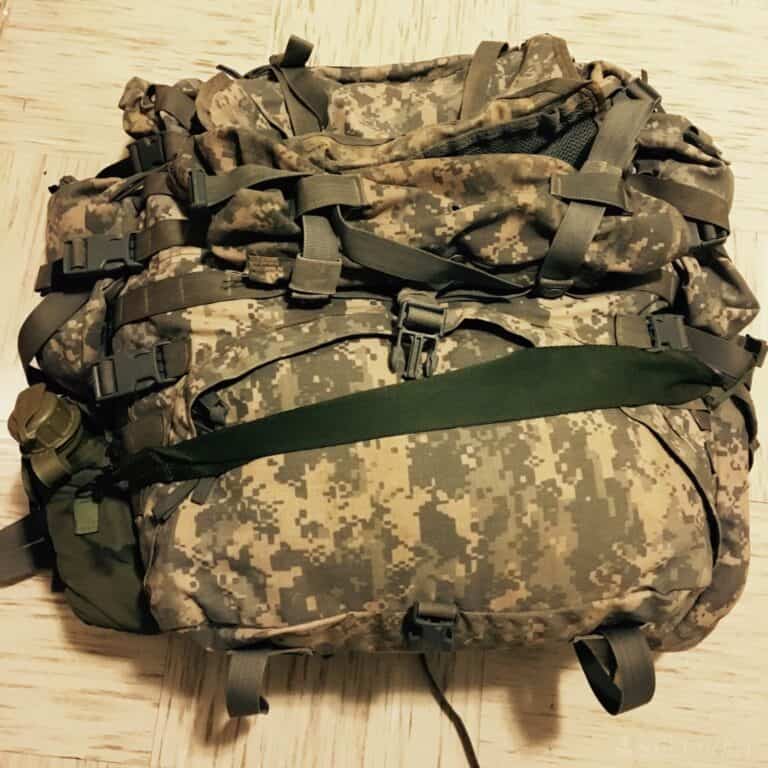If you’re a prepper, you’ve surely heard of a bug-out bag or BOB, but have you heard of an INCH bag?
If there’s one thing that preppers love besides getting all the gear and equipment we think we’ll need to survive a catastrophe, it’s coming up with clever acronyms for our luggage.

United States Army Issue Large MOLLE Ruck – perfect to pack it as an INCH bag.
A BOB is a bug-out bag, a GHB is a get-home bag. But what about an INCH bag? What is an INCH bag, exactly?
An INCH bag, or I’m-never-coming-home bag, is basically a supersized bug-out bag designed to help someone sustain away from home for a fairly long period of time, at least a couple of weeks.
If a bug-out bag is the one you reach for when there is a chance of making it back home or to a pre-selected safe location, the INCH bag is the one you reach for when you really need to head for the hills.
Ideally, an INCH bag will contain everything you need to fully sustain yourself anywhere that you might go.
It is a much bigger bag, and also a much bigger undertaking to assemble one. I’ll tell you more about them below…
Isn’t an INCH Bag Just a BOB?
If you’ve heard an INCH bag talked about in conversations around prepping, personal readiness, and survival you might have come to the conclusion that the term is simply interchangeable with a BOB, or bug-out bag.
This makes sense, because they’re both large bags, usually rucksacks, filled with survival gear. And in fact sometimes the terms are used interchangeably.
But if you want to get really specific about things, these two bags have a separate taxonomy, in a matter of speaking.
Although any given person’s bug-out bag might be a little smaller and leaner, or a little larger and beefier compared to anyone else’s, a bug-out bag is ultimately chosen with a certain amount of practicality and mobility in mind.
An INCH bag, on the other hand, is invariably significantly heavier than that same individual’s bug-out bag.
Where putting together a bug-out bag always revolves around choices, probabilities, tradeoffs and compromises to better ensure mobility and reduce fatigue, the INCH bag might be better thought of as a “kitchen sink bag”.
You pack it knowing it is going to be a monster to move and carry, relatively, in exchange for better capability.
How Long Should an INCH Bag Sustain You?
At least 2 weeks and preferably more. Some people build around the idea that you are really never coming home if you are reaching for it.
An INCH bag will ideally prepare you to you sustain almost indefinitely in a given environment by equipping you with tools and materials to maximize your efforts in that environment.
But there is no set metric for how long an INCH bag should sustain you.
INCH bags, like bug-out bags, are entirely user-specific. That being said, those folks build a bug-out bag with the notion that it will help them survive anywhere from a few days to a week at most.
An INCH bag gives you a clue in the name, “I’m never coming home”, and while it might be a little hyperbolic, it’s not by much.
When I assemble my INCH bag, I want it to help me sustain comfortably with almost zero effort for a week even in the middle of the wilderness, and easily for no less than 2 weeks and beyond.
I do pack it with the intention of supplementing what I carry with natural materials, though.
What Gear Should You Include in an INCH Bag?
An INCH bag will include all of the usual stuff you put in a BOB and a lot more. But beyond this, it will place more emphasis on the inclusion of gear to help you sustain and thrive wherever you happen to be.
Consider the following additions as hallmarks of an INCH bag loadout:
1. Enhanced shelter kit
Consisting of extra cordage, tarps, emergency blankets, tools, fasteners, and more that will allow you to build a more substantial and durable shelter with less time and effort.
2. Rations
Hopefully your environment will supply much of your food if you have the skills, but the INCH bag should provide you with enough food to keep you going for hopefully a whole week, even if it is a lean week.
Pack shelf-stable, high calorie foods, and expanded mess kit to help you make the most of them.
3. Expanded first-aid kit and medications
Digestive ailments, diarrhea, nausea and things like that will be more of a factor than usual. Bring meds accordingly.
Also bring sunscreen, bug sting and bite relief, spare prescription eyewear and what you need to take care of it, any required prescription medications, and so forth.
4. Hygiene kit
You’re going to be out there long enough that keeping yourself in good condition is going to do wonders for you mentally and physically.
Consider bringing a razor, extra deodorant, toenail clippers, etc.
How Heavy is an INCH Bag?
Compared to a BOB, an INCH bag is going to be significantly heavier. Speaking for myself and my peers, most of our INCH bags weigh at least 50 pounds, and several of us have INCH bags weighing 70 pounds or a little over.
This is a tremendous amount of weight to carry if you aren’t in great shape and conditioned to it, so make sure you’re putting in the work so you can actually move it on foot if you have to.
The post So, What Is an INCH Bag? appeared first on Survival Sullivan.
By: Tom Marlowe
Title: So, What Is an INCH Bag?
Sourced From: www.survivalsullivan.com/what-is-an-inch-bag/
Published Date: Wed, 23 Aug 2023 16:00:00 +0000
------------------------
Did you miss our previous article...
https://bushcrafttips.com/bushcraft-news/the-final-weapon-lowprofile-carbine
 What is BushcraftSurvival SkillsToolsVideosBushcraft CampsBushcraft KitsBushcraft ProjectsPrivacy PolicyTerms And Conditions
What is BushcraftSurvival SkillsToolsVideosBushcraft CampsBushcraft KitsBushcraft ProjectsPrivacy PolicyTerms And Conditions
